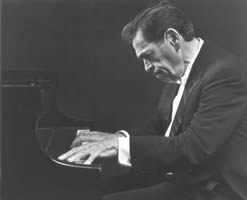Abbey Simon in Concert
|
James David Jacobs [May 2009.]
On Tuesday night (April 21) I had the pleasure of hearing a recital by one of the greatest living pianists, Abbey Simon. At 87 years old, his playing needed no excuses. The occasional missed note or momentary loss of focus was more than compensated for, not only by solid and protean musicianship, but also by his still-formidable technical facility. Today’s pianists think of Simon’s playing style as old-school, and it is true that at times during the concert I felt I was listening to one of those 78 rpm records; apparently it’s not just older recording techniques that evoked that warmer sound from the piano, or created phrases of a longer arch. It certainly was not the crystalline acoustics of the newly refurbished Alice Tully Hall that created that sound, nor was it the glassy tone of the Yamaha piano Mr. Simon played. His sound was forged in a different era, at a time when the performer was expected to invest his personal style into all his interpretations. Simon’s Chopin was by design a very different beast from Horowitz’s Chopin or Rubinstein’s Chopin; after the first bar the experienced listener can tell who is playing — a trait one does not associate with more recent musicians, many of whom now strive to get their own personality out of the way of the musical text. So it’s interesting that the nearest parallel I can think of for Simon’s approach, which most people would dub Romantic, is the playing of recent harpsichordists I’ve heard in Couperin and Rameau. Simon plays in gestures; as in French Baroque music, the bar lines are seen by the performer but not heard by the listener. Simon’s meter is not vague, but neither is it the point: The listener is too occupied with being enraptured by the sweep of the long line to start keeping time. This approach not only gives a sense of spaciousness and breadth to the music, but can also have a clarifying effect. As a result the strict classicism of Clementi is infused with poetry and passion, while the gauziness of Ravel’s impressionism is rendered coherent by Simon’s innate sense of phrasing. Another paradox of this supposedly old-school approach to music-making, in which the performer puts so much of himself into the music, is that every piece sounds modern, as if it’s being improvised. Despite the fact that the newest piece on Tuesday’s program (Ravel’s Miroirs, 1904-05) is over a century old, the entire program sounded fresher and more committed than many new-music concerts I’ve attended. The program began 20 minutes late, which, coupled with the miserably poor attendance, created a sense of dread that was quickly dissipated with the opening notes of Bach’s Toccata in C minor BWV 911, one of the master’s notoriously thorny free-form contrapuntal works that Simon infused with clarity and drama. From the beginning of the concert Simon played with the kind of confidence and energy that’s already starting to wane in most performers half his age. The second piece on the program was by a composer every pianist knows and none fully appreciates: Muzio Clementi. Clementi wrote a piano method that is still used today, as well as a number of pieces tailored for students at various levels of accomplishment. That he was also a serious composer of works for virtuosi was evident from his Sonata in F minor, Op. 13 No. 6, which anticipates Beethoven in its searching drama and unexpected dynamic contrasts. Simon wisely followed this with an actual Beethoven sonata, Les Adieux, in a performance that emphasized its Romantic qualities. The whole program had a sense of time moving forward, not only through its chronological order but in the way Simon demonstrated through his interpretations how the advances made by each piece helped make the next entry on the program possible. The second half of the concert began with a pair of Chopin waltzes, taken at a surprising clip, which further quelled any doubts about Simon’s continued technical prowess. This was followed by Chopin’s F minor Ballade, and this was the only time in the concert when I felt Simon’s concentration start to lag a bit. There were beautifully played moments, but I missed the through-line of the piece as a whole. The concert ended with Ravel’s Miroirs, and Simon was back in full form. To witness this old man attack the fiendishly difficult Alborada del gracioso with full command of the keyboard and its ability to evoke magic and adventure made me lose all fear of aging. He played two encores, Grieg’s Papillon and a Chopin Impromptu. The too-small but appreciative crowd gave him a richly deserved ovation, and Abbey Simon acknowledged the audience with the same grace as if it were a sold-out Carnegie Hall, which it should have been. But at least he can say he’s been there and done that.
[More James David Jacobs]
[Previous Article:
Springtime with Bach]
[Next Article:
Allan Pettersson’s Greatest Hits]
|
